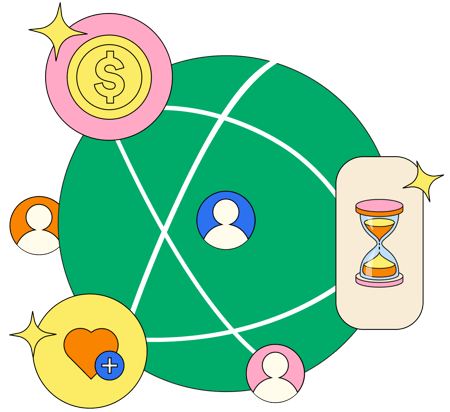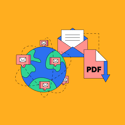
In-Kind Benefits Packages for Global Team Success

Key takeaways
- In-kind benefits are an essential form of compensation to attract top talent and improve worker engagement and retention.
- Companies can choose between the home-country model, the localized method, or a these costs.
- A benefit's taxability and the expense's deductibility are not the same thing. A benefit you provide might be non-taxable to a worker, but you may still be able to deduct the costs of providing that benefit.
What are in-kind benefits?
In-kind benefits are non-cash benefits companies provide workers as part of their overall compensation package.
In-kind benefits are an important component of a comprehensive benefits package. For some workers, these benefits are bonus perks piled on top of an attractive salary. For others, in-kind benefits provide essential services like healthcare and childcare that they couldn’t afford with taxable monetary income alone.
Some in-kind benefits can significantly impact workers’ overall financial situation. For instance, if a company offers to cover an employee’s housing expenses, they help them save a considerable portion of their salary.
Economists Janet Currie and Firouz Gahvari point to the inefficiency of cash transfers and argue that in-kind transfers may be a more efficient way to compensate for the lack of public health and public housing policies.
Advantages of in-kind benefits
In-kind benefits are an essential form of compensation to attract top talent and improve worker engagement and retention.
Attract top talent
A well-thought-out benefits plan helps you stand out among other companies and attract the most qualified workers.
Workers evaluate a company’s benefits package in addition to compensation and company culture when looking for a new job.
Benefits and perks give workers something to get excited about and demonstrate a company’s dedication to their well-being and financial stability.
Retain top talent
Workers place benefits packages as a top reason to look for a position outside their current company. According to SHRM’s 2018 Employee Benefits Report, 92% of surveyed employees said that benefits are essential to their overall job satisfaction resulting in fewer resignations.
Discover how Quantium retained top talent with Deel’s global mobility solutions.
Improved business performance
Companies that nurture a worker-first culture have less burnout and more productive and motivated teams.
Benefits such as flexible working hours allow workers better time management and scheduling, while gym memberships and healthy free meals encourage workers to adopt healthy habits and prioritize maintaining their physical and mental health.
In-kind benefits are also advantageous for companies as they reduce total labor costs.

Methods of providing in-kind benefits to global teams
The best way to provide in-kind benefits depends on where your workers live.
Home-country model
The home-country method enables international workers to receive the same level of benefits as workers that live where the company is based. This model is best suited to workers on short-term international assignments.
On the downside, if the payroll is split between the home and host country, an employee may not receive reimbursement for host country taxes or currency differences, which affect their overall compensation.
Localized method
With the localized method, the company provides the benefits available in the international worker’s host country. This method is most suitable for long-term assignments or workers living abroad permanently. Perks available through this method include housing, pension contributions, and food assistance programs (all included in the total compensation value).
Global method
The global method is a way to offer international benefits in kind to workers who relocate often or live abroad permanently. This model allows workers to plan their finances based on the international benefit types and keep the benefits regardless of where they move.
For instance, particular in-kind programs, such as pension contributions, are centered in the home country, while others depend on an employee’s current location.
Watch our webinar to learn why you should prioritize global benefits.

How to determine which non-mandatory benefits to offer global teams
Choosing the right benefits for your workers depends on your budget, the personal preferences of your workers, and the availability of benefits in the locations where workers live.
Establish a non-mandatory benefits budget
Having a better understanding of how much expenditure you can allocate to your workforce’s benefits lets you make more informed decisions on how much it takes to sustain and grow your global team.
However, not all benefits need to cost money. You can offer engaging perks with minimal upfront costs:
- Flexible working hours
- Work-from-home or work-from-anywhere policies
- Negotiate staff discounts from local vendors
- Mentorship opportunities
Colby Splaine, Internal Comms and Culture HR Partner, Deel
Learn more about how to calculate employee benefits in this article.
Consult your staff
The next step is to talk with your workers and learn what benefits they see as the most important.
Run a benefits survey to understand your workers’ unique preferences and use that information to determine which benefits to include in the benefits plan. Your team wants to feel heard and won’t want irrelevant perks they won’t use.
Casey Bailey, Head of People, Deel
Alternatively, use our Benefits Tool to navigate the statutory, common, and competitive benefits in each market.
Create a list of benefits you’d offer
Once you know what will motivate your workers and make their life easier, create a list of benefits, including non-negotiable and optional perks. You can create different packages for different workers (full-time, part-time, independent contractors).
Consider hiring an experienced benefits broker familiar with available packages and reliable vendors and will create a plan according to your business’s size and budget.
Select a benefits provider
With or without a benefits broker’s help, your next step is to find a benefits provider. You want a provider who can be more than just a vendor and act as your partner, ensuring workers continue to receive benefits aligned with their needs throughout their tenure at your company.
Khizar Naeem, Senior Product Manager API & Partnerships, Deel
Track benefits utilization
Workers’ needs change, and so should the benefits you offer them. So first, track the portion of workers using the benefits you offer. Your benefits vendor will likely provide this functionality.
If utilization is low, consider conducting another survey to determine why. Perhaps workers aren’t aware of the benefits or how to access them.
If you’re spending money on a benefit no one uses, consider replacing it with another perk your workers find valuable.
The most valuable in-kind benefits
Providing a combination of the following benefits will be most valuable to your team.
Childcare allowances
Employers can provide a considerable service to their workers by offering childcare stipends, reimbursement, or even onsite childcare. Especially during the summer, this saves workers the high cost of hiring a private caregiver or building their schedule around pickups and drop-offs.
Healthcare
Workers often list healthcare as the most important compensation element, if only behind salary and wages. Workers, especially in the US, face high healthcare costs and very basic coverage via Medicare.
Important note: Healthcare policies paid directly are usually tax-free to employees.
Subsidized relocation
Providing relocation allowances, reimbursements, or stipends for expats or mobile workers can help workers and their families relocate temporarily or permanently to fulfill their professional and personal needs.
If relocation is temporary, a worker may ask the employer to fund family visits in their home country or relocation assistance at the end of the assignment.
Housing costs
Some companies offer housing allowance to employees. The best-case scenario is when an employer covers an employee’s housing costs without reducing their salary. However, if an employee must cover these expenses independently, that may lower the employee’s tax bracket and rate, increasing take-home pay.
Food costs
When an employee is required to work onsite, an employer may offer free food. It is one of the most popular tax-free in-kind benefits. Also, many employers provide “per-diem” or daily allowances for travel, meals, and lodging.
For employers of low-income populations, subsidizing food costs can replace food stamps programs, guaranteeing access to nutritious meals. Food costs are an extremely valuable benefit to workers who may be routing most of their salary to cover rent and other expenses.
Learn how to manage global benefits from Deel experts
Your hub for improving your global team's working experience. Get a free resource bundle about global perks and benefits.

Other examples of in-kind benefits
Most in-kind benefits give workers financial security and flexibility at work. For example, the following perks help workers focus on assignments rather than worrying about covering certain expenses independently.
- Health insurance
- Life insurance
- Retirement benefits
- Childcare (offered in the office or reimbursed)
- Non-business travel and entertainment expenses
- Work-from-home stipend
- Relocation stipend
- Use of a company car
- Access to a co-working space
- Student loan repayments
- Commuting costs, such as subsidies for public bus services
- Daily allowances for travel, meals, and lodging
In-kind benefits may be tax-deductible to the employer
Examples of deductible benefit expenses include employer-provided housing, employer-provided education, and employer-provided equipment. Check with a tax professional for help qualifying these costs.
A benefit’s taxability and the expense’s deductibility are not the same thing. A benefit you provide might be non-taxable to a worker, but you may still be able to deduct the cost of that benefit.
Bethany Stachenfeld, CEO & Co-founder, Sendspark
Employees may pay taxes on their in-kind benefits
In the US, for example, in-kind benefits that have monetary value are generally considered taxable income, and US workers must include the benefits’ value on tax form W-2 when reporting their earnings from employment.
In the UK, perks like the use of a company car must be valued, and the taxpayer (an employee) pays tax on the taxable value of the benefit using the P11D method.
There are, however, many non-taxable fringe benefits. For instance, in the US, awards for achievements are tax-free. We’ll share more tax-free benefits in the section below.
Tax-free in-kind benefits across the globe
The United Kingdom
- Childcare vouchers
- Commuting expenses
- Moving costs
- Pension contributions
- Business travel accommodations
- Use of a company car (for business use
China
- Housing rental expenses
- Childcare and education expenses
- Language training costs
- Relocation expenses
- Home leave costs
- Meal fee
- Laundry fee
- Business travel expenses
Canada
- Employer-provided private health care insurance
- Childcare costs for an employee working out of town
- Education and professional development costs
- Automobile allowances
- Cell phone and internet services
- Relocations cost reimbursement
The United States
All in-kind benefits in the US are taxable except those included in the tax code. Still, non-taxable perks exist, but specific requirements must be met for employees to become eligible for in-kind benefits.
Expat workers are not entitled to any special provision for in-kind benefits taxability: every benefit, including vehicles, housing, or other living costs, is considered taxable.
The most common tax-free perks in the US are:
- Life and health insurance
- Childcare (up to $5,000 a year)
- Onsite company accommodation and meals
- “Per diem” (business travel expenses, accommodations, and meals)
- Relocation costs
For more information, visit the IRS’s Employer’s Tax Guide to Fringe Benefits.
Belgium
Self-employed individuals and employees must pay progressive income tax and social security based on the earned cash income. However, social insurance and in-kind perks are also employers’ responsibilities.
Qualifying in-kind benefits for favorable tax treatment include:
- Housing and utilities
- Stock options
- Use of company-provided car, cell phone, or computer
These incentives are provided to Belgium nationals. Foreign workers, on the other hand, are entitled to the specific tax-free in-kind benefits:
- Tax equalization
- School fees
- Living costs (up to $2,739)
- Housing expenses
Provide the best benefits for your global team with Deel
Regardless of where your team members live, you want to provide them with the best benefits. However, keeping up with costs, taxes, and providers can take a lot of work.
Deel has partnered with over 150 partners across the globe to give your teams flexible benefits and perks for the best price no matter where they live.
To top it off, Deel lets you hire anyone, anywhere in the world, within minutes. Plus, you can rest assured legal experts vet your contracts and taxes to be completely compliant, so you can feel confident knowing your new hires are set up to work correctly.
Request a demo to learn more.


